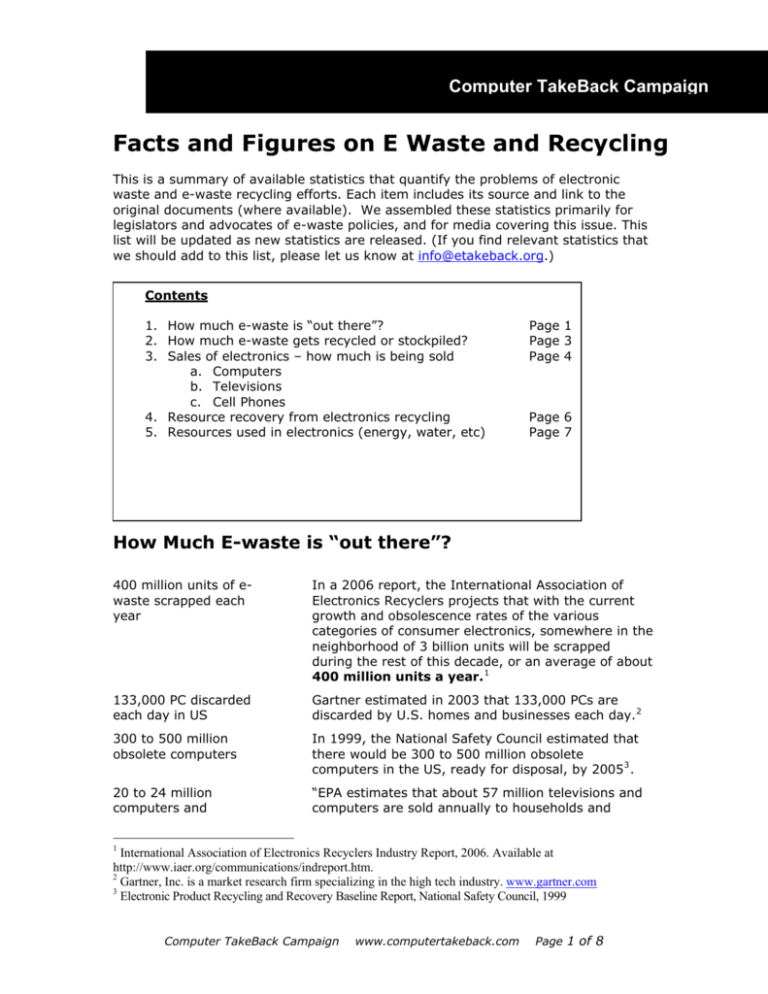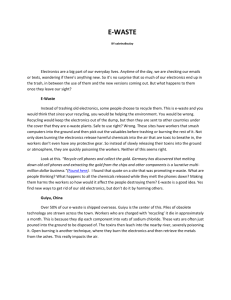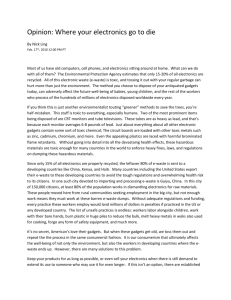Facts and Figures on E Waste and Recycling
advertisement

Computer TakeBack Campaign Facts and Figures on E Waste and Recycling This is a summary of available statistics that quantify the problems of electronic waste and e-waste recycling efforts. Each item includes its source and link to the original documents (where available). We assembled these statistics primarily for legislators and advocates of e-waste policies, and for media covering this issue. This list will be updated as new statistics are released. (If you find relevant statistics that we should add to this list, please let us know at info@etakeback.org.) Contents 1. How much e-waste is “out there”? 2. How much e-waste gets recycled or stockpiled? 3. Sales of electronics – how much is being sold a. Computers b. Televisions c. Cell Phones 4. Resource recovery from electronics recycling 5. Resources used in electronics (energy, water, etc) Page 1 Page 3 Page 4 Page 6 Page 7 How Much E-waste is “out there”? 400 million units of ewaste scrapped each year In a 2006 report, the International Association of Electronics Recyclers projects that with the current growth and obsolescence rates of the various categories of consumer electronics, somewhere in the neighborhood of 3 billion units will be scrapped during the rest of this decade, or an average of about 400 million units a year. 1 133,000 PC discarded each day in US Gartner estimated in 2003 that 133,000 PCs are discarded by U.S. homes and businesses each day. 2 300 to 500 million obsolete computers In 1999, the National Safety Council estimated that there would be 300 to 500 million obsolete computers in the US, ready for disposal, by 2005 3 . 20 to 24 million computers and “EPA estimates that about 57 million televisions and computers are sold annually to households and 1 International Association of Electronics Recyclers Industry Report, 2006. Available at http://www.iaer.org/communications/indreport.htm. 2 Gartner, Inc. is a market research firm specializing in the high tech industry. www.gartner.com 3 Electronic Product Recycling and Recovery Baseline Report, National Safety Council, 1999 Computer TakeBack Campaign www.computertakeback.com Page 1 of 8 E-Waste Facts and Figures televisions are added to storage each year businesses in the United States. These purchasers often do not discard older models when buying newer versions of the same products. Consumers (both business and household) frequently store their retired products. Experts agree that the average household may have between two and three units in storage. The numbers of units (mainly computers) stored by businesses are of course much greater. In total, approximately 20 to 24 million computers and televisions are added to storage each year. Over the next decade, storage is expected to increase at a faster rate because of advances in digital technology for televisions. Just as advances in computer speed and software have made older computers uneconomical to repair, newer digital broadcast standards are likely to reduce the repair and resale value of older televisions.” 4 Cell phones One hundred thirty million cell phones are retired each year 5 2.6 million tons of ewaste disposed in 2005 in USA In 2005, we generated 2.6 million tons of e-waste in the US, or 1.4% of total discards. Of this amount, only 12.6% was recycled, according to the EPA: “As in recent previous updates of this report, generation of selected consumer electronic products was estimated as a subset of miscellaneous durable goods. In 2005, an estimated 2.6 million tons of these goods were generated. Of this, approximately 330,000 tons of selected consumer electronics were recovered for recycling. Selected consumer electronics include products such as TVs, VCRs, DVD players, video cameras, stereo systems, telephones, and computer equipment.“ 6 View fact sheet with visuals charting these statistics (trashed vs recycled) 20 to 50 million metric tons of e-waste disposed worldwide each year “Some 20 to 50 million metric tonnes of e-waste are generated worldwide every year, comprising more than 5% of all municipal solid waste. When the 4 Federal Register: EPA Rule Change Notice: RIN: 2050-AE52, 2002, “Hazardous Waste Management System; Modification of the Hazardous Waste Program; Cathode Ray Tubes and Mercury-Containing Equipment,” Section III.A. Web access at: http://www.epa.gov/fedrgstr/EPA-WASTE/2002/June/Day12/f13116.htm 5 EPA e-Cycling FAQs. http://www.epa.gov/ecycling/faq.htm 6 “Municipal Solid Waste in the United States: 2005 Facts and Figures.” United States Environmental Protection Agency, Office of Solid Waste (5306P) EPA530-R-06-011 October 2006 page 72. Accessible at http://www.epa.gov/msw/pubs/mswchar05.pdf Computer TakeBack Campaign www.computertakeback.com Page 2 of 8 E-Waste Facts and Figures millions of computers purchased around the world every year (183 million in 2004) become obsolete they leave behind lead, cadmium, mercury and other hazardous wastes. In the US alone, some 14 to 20 million PCs are thrown out every year. In the EU the volume of e-waste is expected to increase by 3 to 5 per cent a year. Developing countries are expected to triple their output of e-waste by 2010.” 7 E-waste is still the fastest growing municipal waste stream in the US The category of “selected consumer electronic products” grew by almost 8% (7.79%) from 2004 to 2005, from 2.4 million tons to 2.63 million tons. 8 While it’s not a large part of the waste stream, ewaste shows a higher growth rate than any other category of municipal waste in the EPA’s report. Overall, between 2005 and 2005, total volumes of municipal waste decreased slightly (by 0.66%). Geographic Numbers on Obsolete Electronics “Western Washington households will generate more than one million obsolete electronics in 2005, more than half of which is comprised of used television sets.” 9 “In Washington and Oregon, over 1,600 computers a day are estimated to be disposed of or moved into storage as obsolete.” 10 How Much Electronic Waste Gets Recycled or Stockpiled? Only 12.5% of disposed e-waste is recycled Only 12.5% of the consumer electronic products generated into the municipal waste stream were “recovered” in 2005, down from 12.7% in 2004. This compares to the overall recovery rate of all categories of municipal waste was 32.1% in 2005. A 7 Press Release, “Basel Conference Addresses Electronic Wastes Challenge.” November 27, 2006, United Nations Environment Programme (UNEP). Available at: http://www.unep.org/Documents.Multilingual/Default.asp?DocumentID=485&ArticleID=5431&l=en 8 “Municipal Solid Waste in the United States: 2005 Facts and Figures.” United States Environmental Protection Agency, Office of Solid Waste (5306P) EPA530-R-06-011 October 2006 page 72. Accessible at http://www.epa.gov/msw/pubs/mswchar05.pdf Tables 12 -15, pages 68 to 75 9 Good Guys Electronics Take-back Pilot Project Report, February 2005 Page 7 10 Northwest Product Stewardship Institute Policymakers Bulletin, November 2001 11 Ibid. Table 13 page 69. Note: See page 34 of report for definitions of generation and recovery. Computer TakeBack Campaign www.computertakeback.com Page 3 of 8 E-Waste Facts and Figures total of 330,000 tons were recovered in 2005. 11 68% of consumers stockpile “68 percent of consumers stockpile used or unwanted computer equipment in their homes.” 12 9% of all products sold between 1980 and 2004 are still in storage Where are all the Electronics? (Preliminary numbers from EPA’s new study) 13 • Of all products sold between 1980-2004, almost half are still in use either by the first or subsequent owners • About 42 percent have already been managed via recycling or disposal. • The remaining 9 percent are still in storage • About ½ of products in storage are TVs • About ¼ of products in storage are PCs. • Household Computers In 2005, of household computer-related products sold from 1980 through 2004, – Less than 40 percent are in their “first use” stage (i.e., initial purchaser is still using) – A little over 20% percent are being reused (second owner is using). Sales in Electronics - How Much Electronics Are Being Sold Note: Many statistics on sales are expressed in terms of “units shipped” from the manufacturers into their various sales channels. At least 230 million PCs sold in 2006 Two sources: According to IDC’s Worldwide Quarterly PC Tracker, manufacturers shipped almost 230 million PCs worldwide in 2006. 14 See Table 1 below. According to Gartner Dataquest, 239 million PCs shipped globally in 2006, with 61.1 million of those being shipped to the US. 15 See Table 2 below. 12 HP Fact Sheet, Earth Day 2005. http://www.hp.com/hpinfo/newsroom/press_kits/environment/earthdayfs.pdf 13 “Electronics Waste Management in the US: Preliminary Findings. Presentation by Clare Lindsay, U.S. EPA, Office of Solid Waste to the E-Scrap Conference in Austin, TX, October 18, 2006. These are preliminary numbers (still under review) to be presented in a final report by the EPA in 2007. 14 IDC Press Release, “Slow PC Sales in the United States Constrain Global Outlook While International Growth Remains Strong, According to IDC”, December 20, 2006, IDC Worldwide Quarterly PC Tracker, December 2006. Available at http://www.idc.com/getdoc.jsp?containerId=prUS20497806 Computer TakeBack Campaign www.computertakeback.com Page 4 of 8 E-Waste Facts and Figures 255 million PCs to be sold in 2007 Worldwide PC shipments are forecast to total 255.7 million units in 2007, a 10.5 percent increase from 2006, while PC revenue is projected to reach $213.7 billion, a 4.6 percent increase, according to the latest forecast by Gartner, Inc. 16 PC Sales Growth Trends Table 1: U.S. and Worldwide PC Shipments and Growth, 2004-2008 (in millions) Source: IDC Region 2004 2005 2006* 2007* 2008* Consumer 21.8 23.6 25.0 26.8 29.0 Commercial 36.5 40.3 41.1 43.9 47.2 Total 58.3 63.9 66.1 70.7 76.1 64.9 78.5 89.4 100.0 111.4 Commercial 114.4 129.3 140.0 155.4 171.8 Total 179.2 207.8 229.4 255.4 283.2 USA Units (M) Worldwide Units (M) Consumer Who Sells the Most PCs Worldwide? Table 2 Preliminary Worldwide PC Vendor Unit Shipment Estimates for 2006 (Thousands of Units) Company 2006 Shipments 2006 Market Share (%) 2005 Shipments 2005 Market Share (%) 20062005 Growth (%) Dell Inc. 38,054 15.9 36,752 16.8 3.5 HewlettPackard 38,033 15.9 31,902 14.6 19.2 Lenovo 16,646 7.0 15,010 6.9 10.9 Acer 13,864 5.8 10,115 4.6 37.1 Toshiba 9,184 3.8 7,216 3.3 27.3 Others 123,642 51.6 117,630 53.8 5.1 15 Gartner Dataquest Press Release, Jan 17, 2007, http://home.businesswire.com/portal/site/home/?viewID=news_view_popup&newsLang=en&epicontent=NEWS_VIEW_POPUP_TYPE&beanID=202776713&ndmHsc=v2*A1167829200000*B1170482 214000*DgroupByDate*J2*L1*N1000837*ZFlat+panel+units+shipped&newsId=20070117006106 16 March 20, 2007, Gartner Inc Press Release: http://www.gartner.com/it/page.jsp?id=502458 Computer TakeBack Campaign www.computertakeback.com Page 5 of 8 E-Waste Facts and Figures Total 239,424 100.0 218,626 100.0 9.5 Note: Data includes deskbased PCs, mobile PCs and X86 servers. Source: Gartner Dataquest (January 2007) Television Sales 2.5 MILLION TVs bought for superbowl We Americans bought 2.5 million TVs just for this year’s 2007 SUPERBOWL, according to the National Retail Federation. 17 That’s up from the 1.7 million we bought for last year’s superbowl. 45.5 million TVs sold per year worldwide Global TV unit shipments reached 45.5 million units per year as of the end the third quarter of 2006 (Q4 2005 through Q3 2006). TV revenues were $24.9 billion for that annual period. 18 39.7 million LCD TVs sold in 2006 worldwide Global LCD-TV shipments will rise to 62.5 million units in 2007, up 57 percent from 39.7 million in 2006, according to the firm. This 57 percent growth would be down dramatically from 95 percent growth in 2006, iSuppli (El Segundo, Calif.). North America accounts for 83% of the 50”+ TV market We are buying BIG TVs. While the average TV size in North America is 29.5 inches, North America accounted for 83% of the 50"+ market and 52% of the 40"+ market 19 Cell Phone Sales Over one billion cell phones sold worldwide in 2006 “The worldwide mobile phone market reached a new milestone at the close of 2006, with more than one billion units shipped worldwide over the year. According to IDC's Worldwide Quarterly Mobile Phone Tracker, vendors shipped a total of 1.019 billion units in 2006, or 22.5% more than the 832.8 million units they shipped in 2005. For the quarter ending December 31, 2006, vendors shipped a total of 294.9 million units, or 19.7% more than the 246.4 million 17 Press Release from National Retail Federation: “Television Sales Lead the Way for Super Bowl Sunday, According to RAMA,” available at: http://www.nrf.com/content/default.asp?folder=press/release2007&file=Superbowl07.htm 18 Press Release, DisplaySearch, November 26, 2006, “DisplaySearch Report Indicates Samsung Takes the Top Position in Global TV Units and Revenues,” http://www.displaysearch.com/press/?id=1014 19 DisplaySearch press release, November 27, 2006; “DisplaySearch Report Indicates Samsung Takes the Top Position in Global TV Units and Revenues,” http://www.displaysearch.com/press/?id=1014 Computer TakeBack Campaign www.computertakeback.com Page 6 of 8 E-Waste Facts and Figures units they shipped during 4Q05. This also marked a record shipment volume for a single quarter.”20 When will we reach 2 BILLION cell phone users worldwide? The UN says in 2008: By 2008 the number of cell phone users around the world is projected to reach some two billion. 21 The USGS says 2009: “In the United States, the number of cell phone subscribers increased from 340,000 in 1985 to 180 million in 2004. Worldwide, cell phone sales have increased from slightly more than 100 million units per year in 1997 to an estimated 779 million units per year in 2005. Cell phone sales are projected to exceed 1 billion units per year in 2009, with an estimated 2.6 billion cell phones in use by the end of that year.” 22 Resource Recovery from Recycling Electronics Gold recovery from ewaste recycling “One metric ton (t) of electronic scrap from personal computers (PC’s) contains more gold than that recovered from 17 t of gold ore. In 1998, the amount of gold recovered from electronic scrap in the United States was equivalent to that recovered from more than 2 million metric tons (Mt) of gold ore and waste. 23 Resources Used in Electronics Manufacturing To manufacture one computer and monitor, it “Finally, the production of electric and electronic devices is a very resource-intensive activity. The 20 IDC Press Release, “Record-Setting Fourth Quarter Shipments Propel Worldwide Mobile Phones Past One Billion Unit Mark, Says IDC,“ January 25, 2007, IDC. Available at http://www.idc.com/getdoc.jsp?containerId=pr2007_01_17_133455 21 Press Release, “Basel Conference Addresses Electronic Wastes Challenge.” November 27, 2006, United Nations Environment Programme (UNEP). Available at: http://www.unep.org/Documents.Multilingual/Default.asp?DocumentID=485&ArticleID=5431&l=en 22 U.S. Geological Survey Fact Sheet 2006-3097: Recycled Cell Phones—A Treasure Trove of Valuable Metals, by Daniel E. Sullivan. Last accessed on the web on October 31, 2006 at http://pubs.usgs.gov/fs/2006/3097/ 23 USGS Fact Sheet FS-060-01 July 2001. http://pubs.usgs.gov/fs/fs060-01/ Computer TakeBack Campaign www.computertakeback.com Page 7 of 8 E-Waste Facts and Figures takes 530 pounds of fossil fuels, 48 pounds of chemicals, and 1.5 tons of water. environmental burden due to the production of electrical and electronic products ("ecological baggage") exceeds by far the one due to the production of other household materials. A UN study found that the manufacturing of a computer and its screen takes at least 240 kg (530 pounds) of fossil fuels, 22 kg (48 pounds) of chemicals and 1.5 tonnes of water - more than the weight of a rhinoceros or a car (Kuehr and Williams, 2003).” 24 Last updated: 20 March 2007 24 “E-waste, the hidden side of IT equipment's manufacturing and use,” Environment Alert Bulletin, United Nations Environment Programme, January 2005. Available at: http://www.grid.unep.ch/product/publication/download/ew_ewaste.en.pdf Quote references a compilation called, “Computers and the Environment. Understanding and managing their impact.” Eric Williams and Ruediger Kuehr, Editors, United Nations University, October 2003. Computer TakeBack Campaign www.computertakeback.com Page 8 of 8





